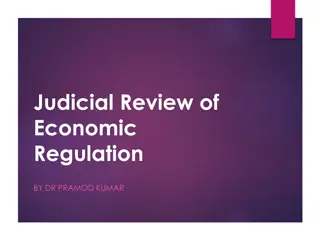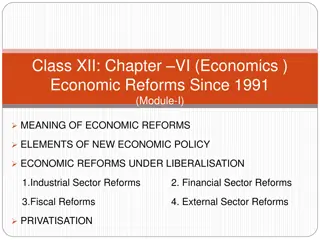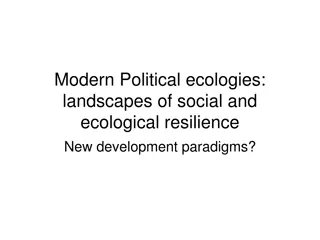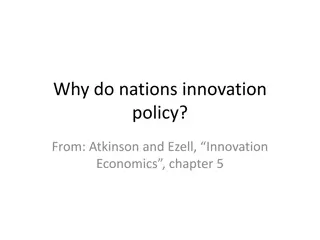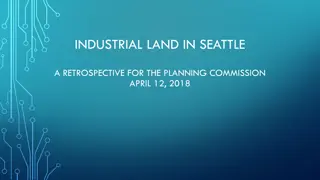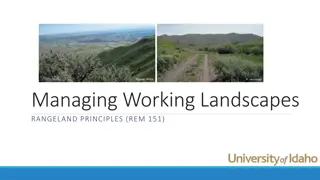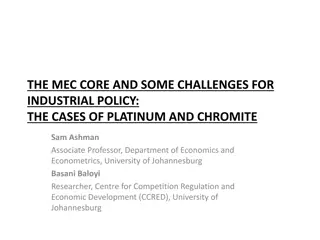The Significance of Industrial Policy for Services in Changing Economic Landscapes
In today's evolving economic landscape, understanding the role of industrial policy in supporting service-based sectors becomes crucial. This discussion emphasizes the need for an industrial policy that adapts to structural changes, prioritizes job quality in services, and rethinks traditional manufacturing-led growth models to navigate the challenges of declining productivity growth. Insights are drawn from patterns of structural change across different regions and their implications for sustaining growth in modern sectors.
Download Presentation

Please find below an Image/Link to download the presentation.
The content on the website is provided AS IS for your information and personal use only. It may not be sold, licensed, or shared on other websites without obtaining consent from the author. Download presentation by click this link. If you encounter any issues during the download, it is possible that the publisher has removed the file from their server.
E N D
Presentation Transcript
WHY SERVICES NEED AN INDUSTRIAL POLICY Dani Rodrik February 2023
Outline Fundamental changes in patterns of structural change Lowering of the underlying growth potential A focus on services and good jobs with a different type of industrial policy
Patterns of structural change: East Asia and advanced countries agriculture manufacturing services informal organized
Patterns of structural change: low-income countries today agriculture manufacturing services informal informalization of manufacturing premature de-industrialization organized
Traditional, manufacturing-led growth Manufacturing employment formal employment formal employment
versus African model Manufacturing employment formal employment formal employment
The declining growth dynamic of structural change In high growth countries, labor used to move from low productivity to higher productivity, and productively dynamic sectors formal manufacturing, traditionally Now the movement is to sectors that may have initially higher productivity (compared to traditional agriculture) but are productively not dynamic mainly services, but also small-scale, informal manufacturing
Greater structural change => lower productivity growth in modern sectors in Africa Negative correlation between contributions of structural change and within-modern sector productivity growth in recent growth Source: Diao et al. (2022) based on the Economic Transformation Database, 2021. Notes: There are 16 African countries in the figure, and they are Burkina Faso (BFA), Cameroon (CMR), Ethiopia (ETH), Ghana (GHA), Kenya (KEN), Lesotho (LSO), Mozambique (MOZ), Malawi (MWI), Namibia (NAM), Nigeria (NGA), Rwanda (RWA), Senegal (SEN), Tanzania (TZA), Uganda (UGA), South Africa (ZAF), and Zambia (ZMB).
versus Asia Positive correlation between contributions of structural change and within-modern sector productivity growth in recent growth Source: Diao et al. (2022) based on the Economic Transformation Database, 2021.
Can services drive rapid growth? Need to understand why (formal) manufacturing was formidable growth engine: 1. productivity dynamics unconditional convergence 2. labor absorption capacity intensive in low-skill labor (traditionally) 3. tradability can expand without turning terms of trade against itself
What is different now? Changing nature of manufacturing technologies to understand why (formal) manufacturing was formidable growth engine: 1. productivity dynamics unconditional convergence 2. labor absorption capacity intensive in low-skill labor (traditionally) 3. tradability can expand without turning terms of trade against itself
The services conundrum Two types of services high-productivity (tradable) segments of services cannot absorb as much labor since they are typically skill-intensive IT, FIRE, business services (IND, PHL) low productivity (non-tradable) services cannot act as growth poles since they cannot expand without turning their terms of trade against themselves continued expansion in one segment relies on expansion on others limited gains from sectoral winners
Key question facing development strategy: where will the good jobs come from? Good jobs = productive jobs mandates/standards (e.g. minimum wages) or employment subsidies at best partially effective education/training works, but only in the long run Necessity of creating good jobs in (mostly domestic) services and SMEs Good jobs require good firms Hence the need for a mixture of interventions on both supply- and demand-sides of labor market education & training important but not adequate if good firms are not there new kind of industrial policy : increase demand for less-educated, lower- skill workers by increasing productivity of such workers and the firms that employ them
New type of industrial policies Collaborative and iterative relationship with firms instead of top-down, arms -length, ex-ante rules Customized assistance to firms with soft conditionality on job creation instead of subsidies and tax incentives Focused not smaller and mid-sized, mostly services firms instead of export champions and most productive segments of the economy Based on quid-pro-quo: firms need access to stable, skilled workforce, reliable horizontal and vertical networks (w/out holdup, informational problems), technology, contractual and property rights enforcement governments need firms to internalize good jobs externalities in employment, training, investment, and technological choices deep uncertainty precludes simple remedies (such as Pigovian employment subsidies)
Externalities targeted Traditional industrial policy R&D, innovation, learning externalities; coordination failures in investment Manufacturing, tradable sectors Largely services (in addition to Approach proposed here Good-job externalities in local economic development and direction of innovation Sectors manufacturing) SMEs Firms Large, globally competitive firms Governments can identify market failures ex ante and is sufficiently insulated from capture Assumptions about the government Knowledge about location and magnitude of market failures is widely dispersed; government faces substantial uncertainty; state capacity is endogenous A portfolio of business services, including marketing, management & tech assistance, customized training, infrastructure, seed capital/loans for directed technologies Customized to firms needs and adapted to context Types of incentives Tax, credit subsidies Application of incentives Fixed schedule of incentives, except for incentive packages for large firms which may be negotiated Ex ante eligibility criteria Selection criteria Voluntary buy-in and participation Soft; provisional, open-ended and evolving Collaborative, iterative; active project management Conditionality Hard; rigid ex-ante criteria Relationship with recipients Arms -length
Reconsidering development policy At what stage of the economy does policy intervene? pre-production production post-production low productivity Which segment of the economy do we care about? middle productivity high productivity
Traditional poverty- reduction & social protection model At what stage of the economy does policy intervene? pre-production production post-production investments in education and training cash transfers; full- employment macro policies low productivity Which segment of the economy do we care about? safety nets middle productivity high productivity
Traditional industrial & growth policies At what stage of the economy does policy intervene? pre-production production post-production low productivity Which segment of the economy do we care about? middle productivity innovation systems, IPR rules, trade agreements subsidies, R&D incentives corporate tax incentives high productivity
The good-jobs development model At what stage of the economy does policy intervene? pre-production production post-production low productivity Which segment of the economy do we care about? promotion of higher- quality jobs in SMEs through: employer- linked training policies; wage subsidies; customized business incentives & services middle productivity high productivity
The convergence of social and growth policies Inclusion/equity possible only through creation of productive jobs in sectors that can absorb low-educated workers Growth possible only by expanding productivity (and employment) in labor- absorbing sectors











